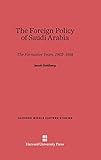The Foreign Policy of Saudi Arabia : The Formative Years / Jacob Goldberg.
Material type: TextSeries: Harvard Middle Eastern Studies ; 19Publisher: Cambridge, MA : Harvard University Press, [2013]Copyright date: ©1986Edition: Reprint 2014Description: 1 online resource (231 p.) : illustrationsContent type:
TextSeries: Harvard Middle Eastern Studies ; 19Publisher: Cambridge, MA : Harvard University Press, [2013]Copyright date: ©1986Edition: Reprint 2014Description: 1 online resource (231 p.) : illustrationsContent type: - 9780674281837
- 9780674281844
- online - DeGruyter
| Item type | Current library | Call number | URL | Status | Notes | Barcode | |
|---|---|---|---|---|---|---|---|
 eBook
eBook
|
Biblioteca "Angelicum" Pont. Univ. S.Tommaso d'Aquino Nuvola online | online - DeGruyter (Browse shelf(Opens below)) | Online access | Not for loan (Accesso limitato) | Accesso per gli utenti autorizzati / Access for authorized users | (dgr)9780674281844 |
Frontmatter -- PREFACE -- CONTENTS -- INTRODUCTION -- 1. THE FORMER SAUDI STATES -- 2. THE MOLDING OF A STATESMAN -- 3. RECOGNITION OF OTTOMAN SOVEREIGNTY, 1902-1912 -- 4. SAUDI-OTTOMAN-BRITISH AMBIGUITIES, 1913-1914 -- 5. INDEPENDENCE AND BRITISH PROTECTION, 1914-1915 -- 6. BETWEEN THE HAMMER AND THE ANVIL, 1916-1918 -- 7. PATTERNS OF SAUDI FOREIGN POLICY -- APPENDIXES A-C. BIBLIOGRAPHY. NOTES. INDEX -- APPENDIX A. TREATY BETWEEN IBN SAUD AND THE TURKS -- APPENDIX Β. DRAFTS OF THE ANGLO-SAUDI TREATY -- APPENDIX C. THE ANGLO-SAUDI TREATY, DECEMBER 1915 -- BIBLIOGRAPHY -- NOTES -- INDEX -- HARVARD MIDDLE EASTERN STUDIES
restricted access online access with authorization star
http://purl.org/coar/access_right/c_16ec
The rise of the House of Saud in the mid-eighteenth century led to the creation of two successive Saudi states which were supported by two key groups, the religious Wahhabi and the dynastic Saudi. The central objective in the relationship between these groups was to convert the population to Wahhabism, with the Saudi dynasty providing the military and political power to wage wars of occupation and proselytism. The major conclusion of this book is that this relationship ceased to exist when Ibn Saud came out of exile in 1902 to establish the third Saudi state. Jacob Goldberg's Saudi perspective, unlike the British perspective of earlier studies, focuses on the marked changes in the years from 1902 to the disappearance of the Ottomans in 1918. Ibn Saud had spent his formative years in exile in Kuwait, witnessing the international politics and intrigues of that region. When he returned to head the new Saudi state, his goal was the reinstatement of the House of Saud in Arabia and the restoration of its former dynastic dominions, but not the propagation of the Wahhabi doctrine. Territorial ambitions were modified by considerations of realpolitik. This pragmatic reversal accounts, in part, for the ability of the new state to survive. By focusing on the roots of Saudi foreign policy, the author highlights the distinctive characteristics that make Saudi Arabia inherently different from other Middle Eastern states.
Mode of access: Internet via World Wide Web.
In English.
Description based on online resource; title from PDF title page (publisher's Web site, viewed 24. Aug 2021)


